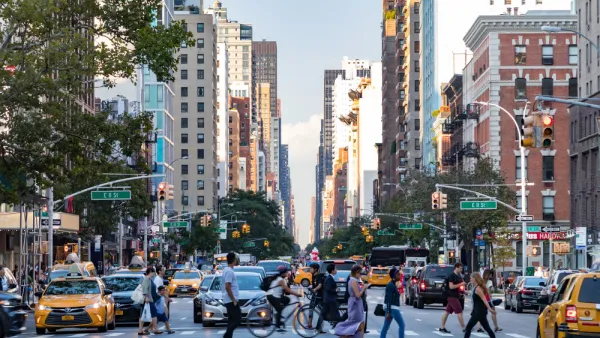Patrick J. Kiger looks at the global trends that will impact urban landscapes over the next 50 years and explores two competing visions for the future of land use.
"Despite the likely longevity of existing structures, most futurists say a vast number of new buildings will be needed to house a U.S. population that will grow by more than one-third by 2063," says Kiger. "But they disagree about where and how that development should occur."
"By 2063, the suburban tract house and the shopping mall will have gone the way of the dinosaurs, and a generation of workers in the knowledge-based economy will flock to high-density, walkable urban mixed-use neighborhoods," say one camp of futurists. Christopher Leinberger, director of George Washington University’s Center for Real Estate and Urban Analysis and one prominent exponent of this view, "calculates that it will take at least until 2040 just to fill the pent-up demand for walkable urban environments, and that the market for such development will continue to grow into the late 21st century."
"Others envision a strikingly different scenario, in which 50 years from now, people increasingly will forsake the cities for the rural countryside," notes Kiger. "They will live in updated, technologically advanced, and economically self-sufficient versions of the 19th-century village."
"With broadband internet access and telecommunications links to the rest of the world, inhabitants of 21st-century villages will be able to do business without the need to commute to a major city, and they will be conveniently close to sources of food and energy," he adds. Chapman University scholar Joel Kotkin, a proponent of this alternative scenario, "predicts that these new communities will develop cultural and artistic amenities that Americans have come to expect from big cities."
"It may turn out, of course, that both scenarios for the state of land use in 2063 come to pass—or that neither does, just as past seers’ predictions of mile-high skyscrapers, plastic houses, flying cars, and networks of tubes under cities that would deliver freshly cooked meals somehow failed to materialize."
FULL STORY: Imagining Land Use in 2063

Analysis: Cybertruck Fatality Rate Far Exceeds That of Ford Pinto
The Tesla Cybertruck was recalled seven times last year.

National Parks Layoffs Will Cause Communities to Lose Billions
Thousands of essential park workers were laid off this week, just before the busy spring break season.

Retro-silient?: America’s First “Eco-burb,” The Woodlands Turns 50
A master-planned community north of Houston offers lessons on green infrastructure and resilient design, but falls short of its founder’s lofty affordability and walkability goals.

Test News Post 1
This is a summary

Analysis: Cybertruck Fatality Rate Far Exceeds That of Ford Pinto
The Tesla Cybertruck was recalled seven times last year.

Test News Headline 46
Test for the image on the front page.
Urban Design for Planners 1: Software Tools
This six-course series explores essential urban design concepts using open source software and equips planners with the tools they need to participate fully in the urban design process.
Planning for Universal Design
Learn the tools for implementing Universal Design in planning regulations.
EMC Planning Group, Inc.
Planetizen
Planetizen
Mpact (formerly Rail~Volution)
Great Falls Development Authority, Inc.
HUDs Office of Policy Development and Research
NYU Wagner Graduate School of Public Service


























